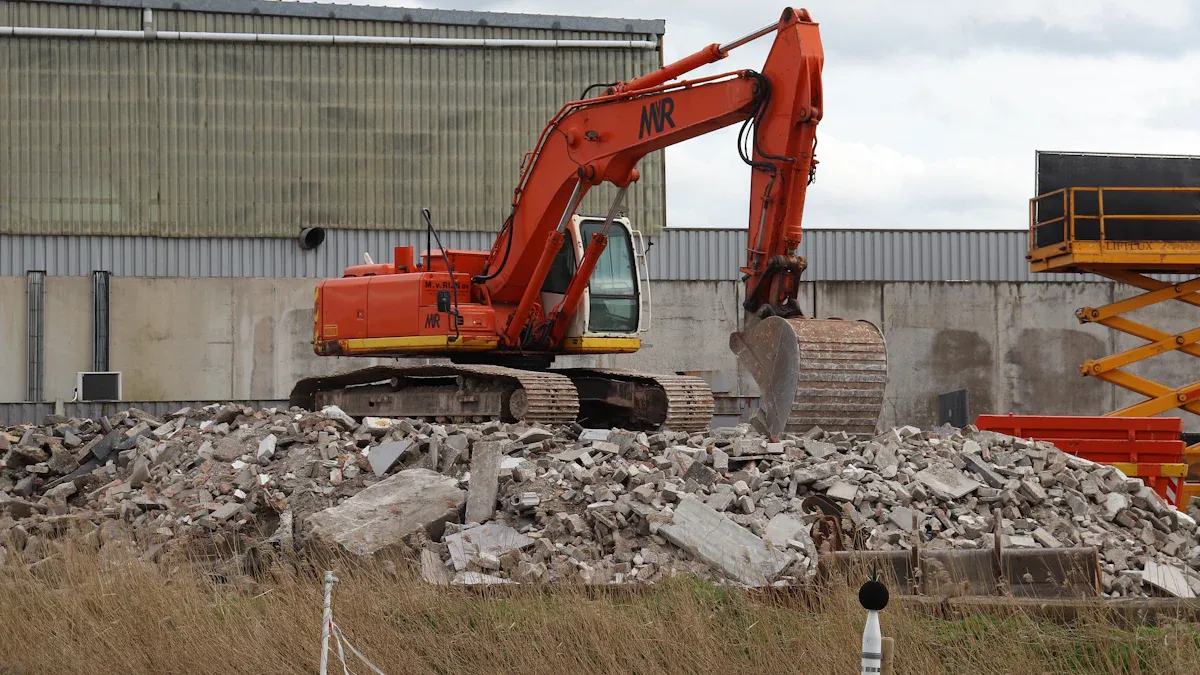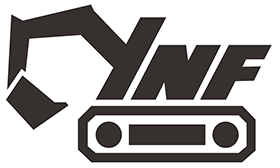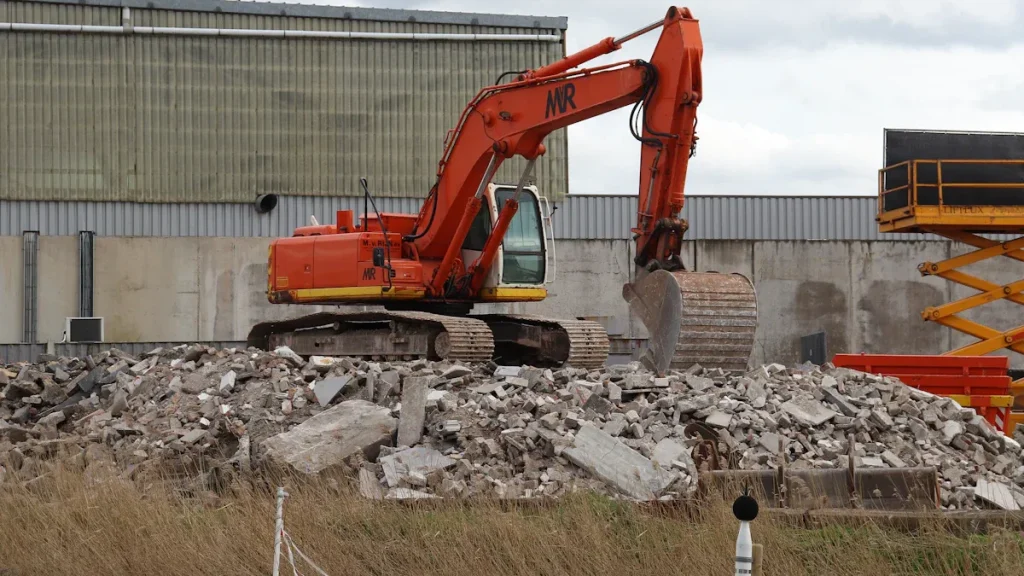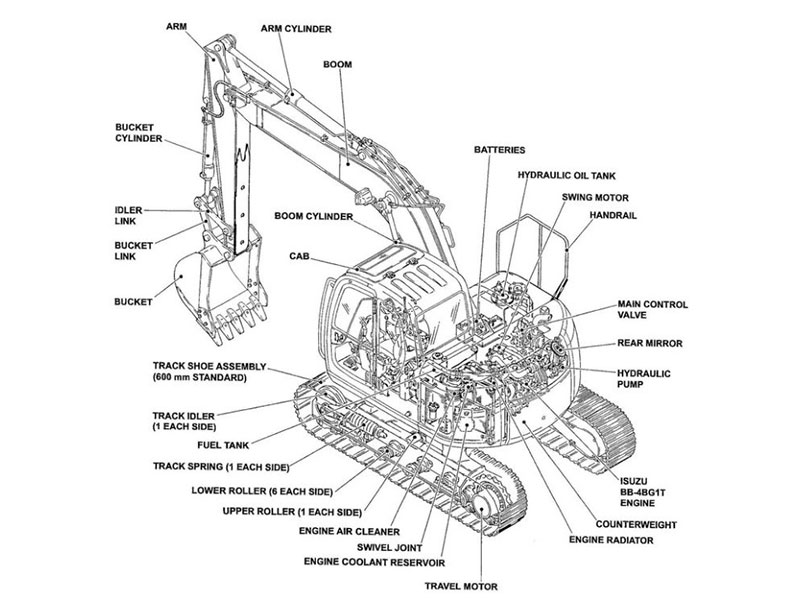
A backup ring is a simple but vital component found in many hydraulic systems. In excavator parts back up ring designs, it sits next to seals and helps prevent leaks. This ring protects the seal from high pressure and stops it from being squeezed out of place. Understanding how backup rings work can help keep machines running smoothly and reduce costly repairs.
Key Takeaways
Backup rings help hydraulic seals stay in place. They stop leaks when the pressure is high. They keep seals safe from damage, dirt, and wearing out. This helps seals last longer and work better. Backup rings are made from PTFE, metals, or elastomers. These materials can handle heat, pressure, and rubbing. Putting backup rings in the right spot is important. Checking them often keeps the system safe and working well. Changing old or broken backup rings early stops leaks. It also saves money on repairs and keeps excavators working.
What Is a Back Up Ring
Definition
A backup ring is a part that supports seals in hydraulics. It sits right next to a seal inside the system. The backup ring helps the seal stay in place. It lets the seal work even when pressure is high. In excavators, this ring stops the seal from moving out because of strong hydraulic force. Engineers often use backup rings in full radial back ups. This gives more support to seals in big machines.
Materials
Manufacturers pick different materials to make backup rings for excavators. Each material has special features for different jobs. The table below lists common materials and what they do:
Material Type | Common Materials Used | Key Properties and Applications |
|---|---|---|
Elastomers | NBR, FKM, HNBR, PU | Give basic support against squeezing; used for standard backup rings; work well under pressure and heat. |
PTFE (Polytetrafluoroethylene) | PTFE, PTFE-Bronze, PTFE-Carbon | Resist chemicals, have low friction, good for tough places and fast movement. |
Metals | Bronze | Very strong and tough for very high pressure; used in big machines like excavators. |
Plastics | Poliamide, POM | Used as support rings; last long, slide easily, and reduce shaking. |
Note: Some piston seals in excavators use bronze or PTFE rings with poliamide support rings. This mix gives low friction, strong protection, and helps the rings last a long time. These materials let backup rings handle hard work in hydraulics.
Basic Function
The main job of a backup ring is to protect the hydraulic seal. It does this by:
Stopping oil from breaking down the seal
Helping the seal last longer
Resisting wear and tear
Stopping the seal from being pushed out
Handling tough work conditions
Keeping dust out
A backup ring keeps the seal from being pushed out when pressure is high. It also helps block dirt and dust from getting in. This support makes the seal last longer and keeps the hydraulics working well. When backup rings do their job, they stop leaks and help the excavator stay safe.
Excavator Parts Back Up Ring Function

Placement
Excavator parts back up ring components sit in key spots inside hydraulic systems. Manufacturers place these rings in hydraulic cylinder seals, such as piston seals and main oil seals. These locations include the hydraulic rods, pistons, and cylinders. The backup ring fits right next to the seal. This position helps the seal stay in place during tough work. In excavator hydraulics, backup rings form part of the seal kits used in heavy construction equipment. Their placement ensures that the system can handle high pressure without leaks.
Tip: Always check the placement of the excavator parts back up ring during maintenance. Proper placement keeps the hydraulic system running smoothly.
Seal Support
The excavator parts back up ring gives strong support to seals. It sits behind the seal and helps it keep its shape. When the hydraulic system faces high pressure, the backup ring stops the seal from moving or breaking. This support is very important for O-rings. The backup ring prevents the O-ring from squeezing out or changing shape. It also helps the seal keep its sealing power. Backup rings use tough materials like PTFE to handle heat and pressure. This support keeps the seals working well and stops leaks in hydraulics.
The backup ring:
Stops the seal from being pushed out
Keeps the seal in the right shape
Helps the seal last longer
High Pressure Use
Excavator parts back up ring designs work best in high-pressure hydraulic systems. These rings protect seals from damage when the system faces strong force. In hydraulics, pressure surges can happen fast. The backup ring keeps the seal safe during these times. It blocks the seal from being forced out of its spot. This action keeps the hydraulic cylinder working without leaks. The backup ring also helps the seal handle harsh work and sudden changes in pressure. By doing this, it makes the whole hydraulic system more reliable.
Note: Using the right excavator parts back up ring helps the hydraulic system last longer and work better under high pressure.
Importance
Problems Prevented
Backup rings are very important in excavator hydraulic systems. When pressure gets high, the seal can move out of its spot. This is called extrusion. Extrusion can cause leaks and make the system fail. Backup rings stop this by holding the seal steady. They also keep dirt and tiny bits from getting inside. This helps the seals stay clean and work well. Without backup rings, seals wear out faster. They also stop keeping oil inside the cylinder.
System Reliability
A good hydraulic system needs strong seals. Backup rings help the seal keep its shape and spot. This is true even when pressure jumps up. This support lets the system do hard work without breaking. Backup rings also help make a thin oil film between the seal and cylinder wall. This film lowers friction and helps the seal move easily. When the seal works right, the hydraulic system stays safe and works well. Operators can trust their excavators every day.
Tip: Check backup rings and seals often. This helps stop sudden breakdowns and saves money on repairs.
Seal Life
Backup rings help seals last longer in tough places. They stop the seal from being pushed out. They also help the seal fight damage from dirt and pressure changes. Backup rings let a thin oil film form, even after not using the machine for a while. This film keeps friction low and protects the seal from wearing out early. Backup rings also help the seal fight damage from pressure spikes and dirt. These things help seals stay strong, wear less, and last longer in excavators.
Benefits of backup rings for seal life:
Stop extrusion when pressure is high
Help make a thin oil film
Lower friction and wear
Fight dirt and particles
Make seals last longer
Maintenance
Signs of Issues
Operators can spot problems with a backup ring by watching for certain signs. Leaks around the hydraulic cylinder often show that the backup ring or the seal has failed. Oil on the outside of the cylinder means the system does not hold pressure. Sometimes, a backup ring may look worn, cracked, or flattened. These changes can make the seal lose its shape. If the seal looks damaged or out of place, the backup ring may not support it well. Unusual noises or jerky movement in the hydraulic system can also point to seal or backup ring issues.
Tip: Regular visual checks help catch problems early before they cause bigger failures.
Best Practices
Good maintenance keeps the backup ring and seal working well. Operators should clean the area around the hydraulic cylinder before opening it. This step stops dirt from getting inside. Always use the right tools to remove and install the backup ring. Avoid sharp objects that can scratch the seal or the cylinder. Lubricate the seal and backup ring before putting them back. This action helps them slide into place and prevents damage. Keep a record of all maintenance work. Tracking changes helps spot patterns and plan future checks.
Clean parts before inspection
Use proper tools for removal and installation
Lubricate before assembly
Keep maintenance records
Replacement
Backup rings and seals do not last forever. Replace them if they show signs of wear, damage, or if leaks appear. Always choose the correct size and material for the backup ring and seal. Follow the manufacturer’s instructions for replacement. After installing new parts, test the hydraulic system for leaks and smooth movement. Early replacement prevents bigger problems and keeps the excavator safe.
Step | Action |
|---|---|
1. Inspect | Check for wear, cracks, or leaks |
2. Remove | Take out old backup ring and seal |
3. Clean | Wipe down all surfaces |
4. Install | Fit new backup ring and seal carefully |
5. Test | Run system and check for leaks |
Backup rings are very important in excavator hydraulic systems. They stop the seal from being pushed out and leaking, even when pressure is high. Checking and taking care of them often gives many long-term benefits:
They do not rust easily and work well in tough places.
They slide smoothly, so parts do not wear out fast or waste energy.
They keep things sealed tight and help machines last longer.
Experts say to pick the best backup ring material, like PTFE, because it lasts a long time and is easy to take care of. Taking care of backup rings helps excavators work well and saves money by stopping long breaks.
FAQ
What does a backup ring do in an excavator hydraulic system?
A backup ring supports the main seal. It stops the seal from being pushed out by high pressure. This keeps oil inside the system and prevents leaks.
How often should operators check backup rings?
Operators should inspect backup rings during every scheduled maintenance. Checking them often helps catch wear or damage early. This keeps the hydraulic system safe and working well.
Can a backup ring be reused after removal?
Experts recommend using a new backup ring after removal. Old rings may lose shape or strength. Reusing them can lead to leaks or seal failure.
What happens if a backup ring fails?
A failed backup ring can cause the seal to move out of place. This may lead to oil leaks, loss of pressure, and possible damage to the hydraulic system. Quick replacement prevents bigger problems.





